Strap leaf anthuriums or pendent anthuriums are the perfect addition to any space. With their spectacular belt-like leaves, these long-leafed plants bring the exotic feel of rainforest into any space.
Most well-known strap leaf anthuriums include Anthurium vittarifolium, Anthurium pallidiflorum, Anthurium pendens, Anthurium wendlingeri, Anthurium friedrichsthalii, and Anthurium gladiifolium.
Pendent anthuriums refer to anthurium species with their growth tip, or apex, always growing downwards. These rare aroids hang down attached to the trees in their natural environment, the tropical rainforest.
Their leaves are like neckties and look perfect hanging down from shelves. Strap leaf anthuriums are relatively easy to care for and give an instant statement look to any room.
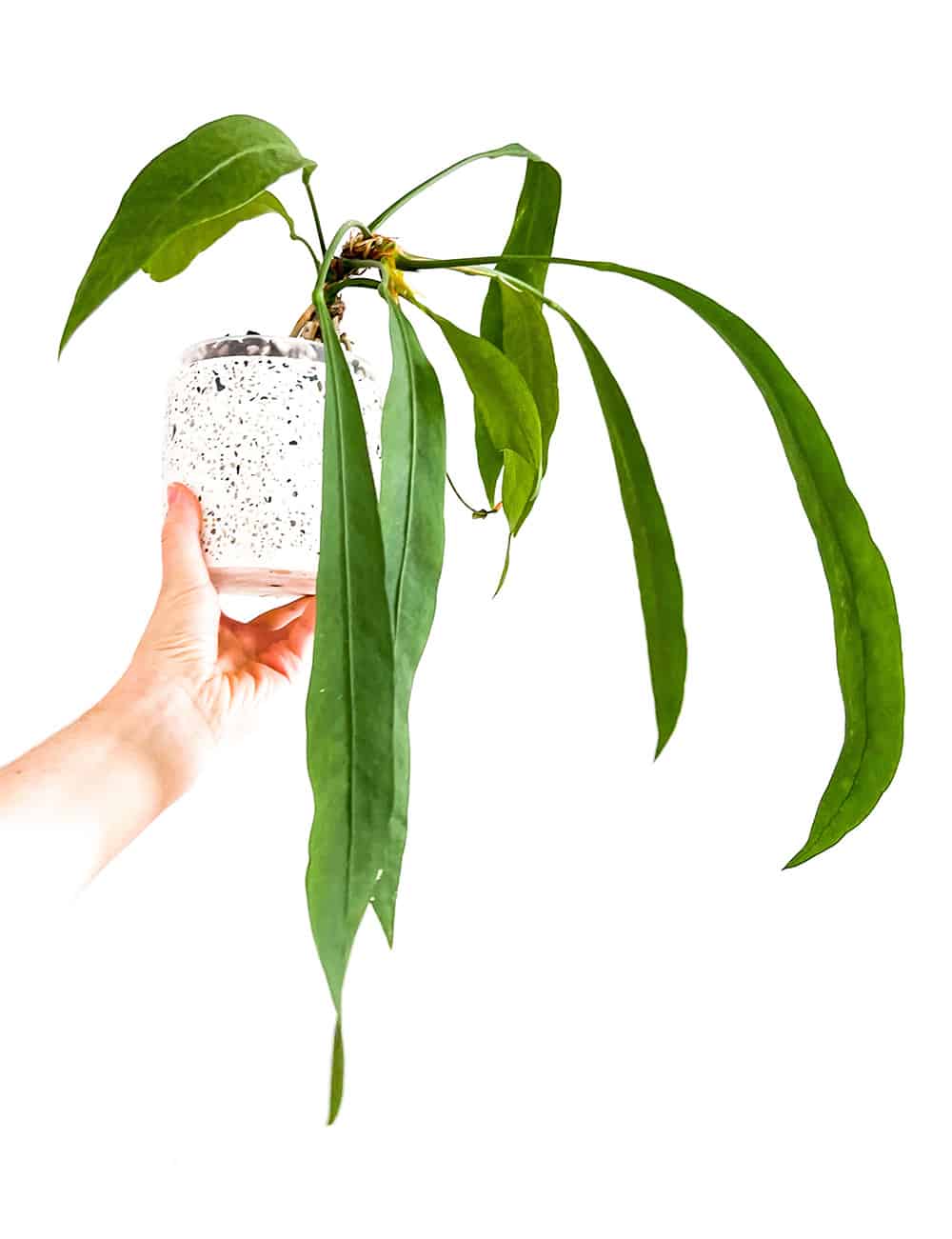
ANTHURIUM VITTARIFOLIUM
Anthurium vittarifolium is one of the most striking strap leaf anthuriums native to the rainforests of Colombia. It has spectacular long narrow strap leaves that can grow 2 meters long! It should be spelled correctly as vittariifolium, with double “ii,” but almost no one does.
The leaves on a mature plant are deep dark green, matte, and resemble a leather belt in texture. It has a prominent midrib and long petioles. In my experience, a prolific grower pushes new strappy leaves all the time if given the right conditions. It also grows quite an extensive root system demanding bigger pots frequently.
Once Anthurium vittarifolium reaches maturity, it frequently produces inflorescences and self-pollinates. The berries on Anthurium vittarifolium are pinkish-red, and its seeds are very easy to germinate.
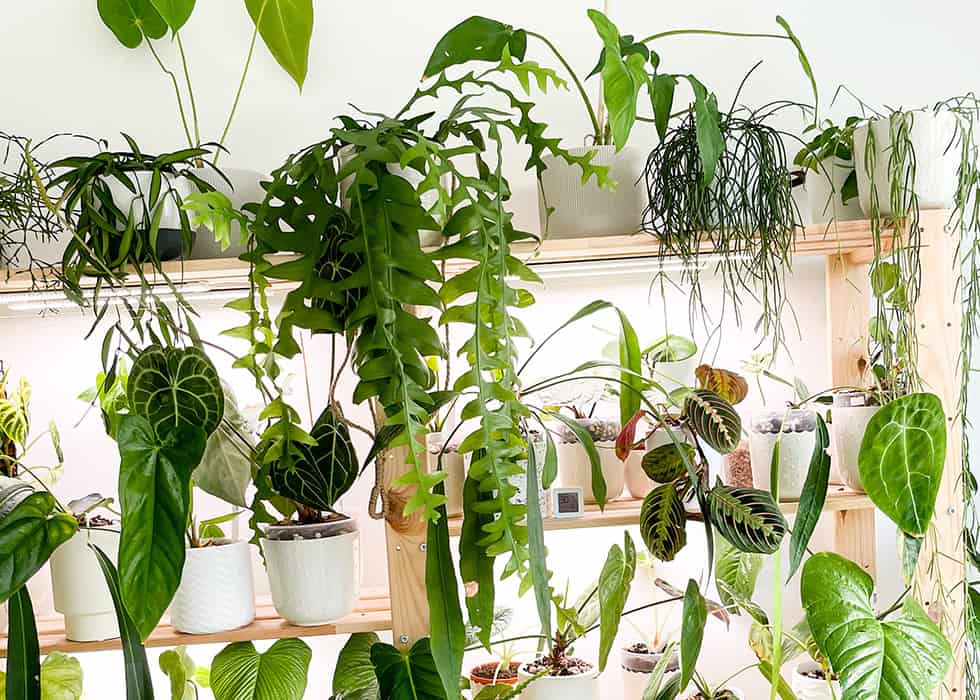
How to care for Anthurium Vittarifolium
Anthurium vittarifolium care is similar to other epiphytic anthurium species. As an epiphyte, it lives attached to a host plant and uses it as support. In the case of strap leaf anthurium, it is a tropical rainforest tree. How it grows in nature gives clues about what it likes regarding care.
LIGHT REQUIREMENTS
Living under the canopy of a tropical rainforest, it prefers bright indirect light but no direct sunlight, which would scorch the leaves.
Most houseplant enthusiasts underestimate the amount of light anthurium vittarifolium needs. Keep it close to the window where it will get filtered light or supplement with grow lights.
My anthurium vittarifolium grows on a plant shelf under grow lights.
WATERING
In its natural environment, Anthurium vittarifolium gets rained on a lot, but the roots never sit in water as it quickly drips down a tree trunk.
It likes to have its roots moist but not soggy wet. If you use a chunky growing medium that drains fast, this strap leaf anthurium will be very happy.
POTTING MIX
While it is not feasible to recreate the tropical rainforest environment indoors for Anthurium vittarifolium, you can strive to provide the best care conditions possible. A well-draining, airy, chunky potting mix of orchid bark, coco chips, perlite, and charcoal is excellent for this strap leaf anthurium.
I’ve seen Anthurium vittarifolium grown in sphagnum moss, and they loved it! But keeping the sphagnum moss from drying requires extra care, depending on how involved a plant parent you want to be.
I start seedlings in moss, but once they are established, I pot them up in a soilless aroid mix which stays moist longer.
TEMPERATURE
Anthurium vittarifolium will thrive in your home if you keep the warm temperatures steady all year round. The ideal temperature is around 20-30C (68-86F).
HUMIDITY
Anthurium vittarifolium naturally grows in a humid environment, and if you can provide conditions of 60% humidity and above, you’ll see good growth.
While it is true that this strap leaf anthurium is not fussy and can be grown well in a room environment, you’ll see better results if you can increase the humidity level. Also, good airflow is essential.
Overall, it is an easy and fast-growing anthurium, which makes it a great indoor plant.
For a more in-depth discussion on anthurium care indoors, see my Anthurium magnificum blog.
How to grow Anthurium Vittarifolium
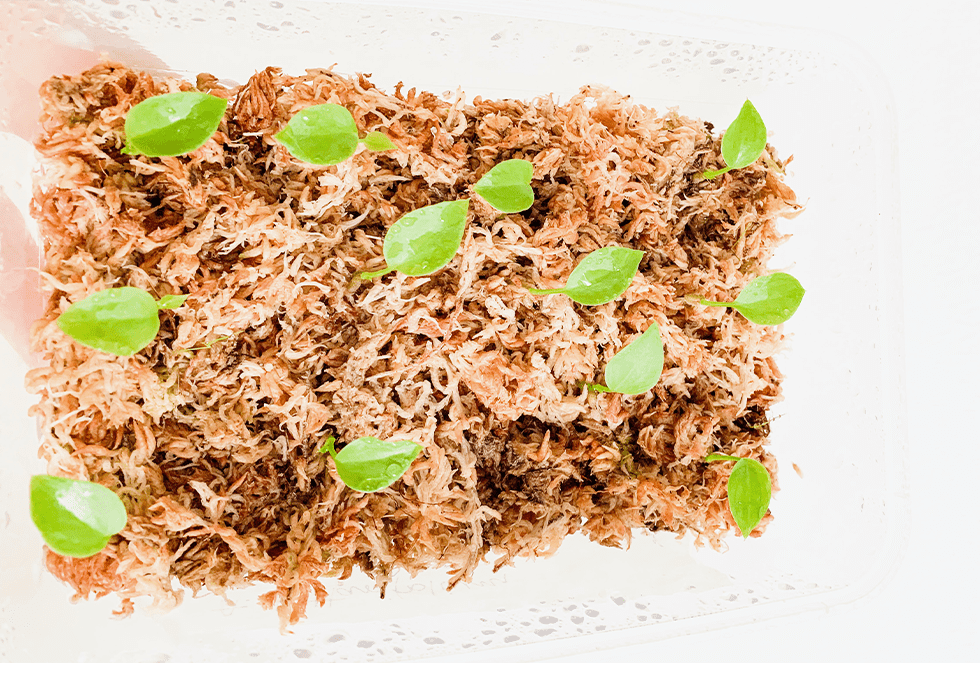
Often the most rewarding experience for a plant enthusiast is to see a plant grow through all its stages, from pollination to a mature specimen.
Here you can see how to propagate Anthurium vittarifolium and the growth progress of my necktie plant. Anthurium vittarifolium seeds readily and germinates fast.
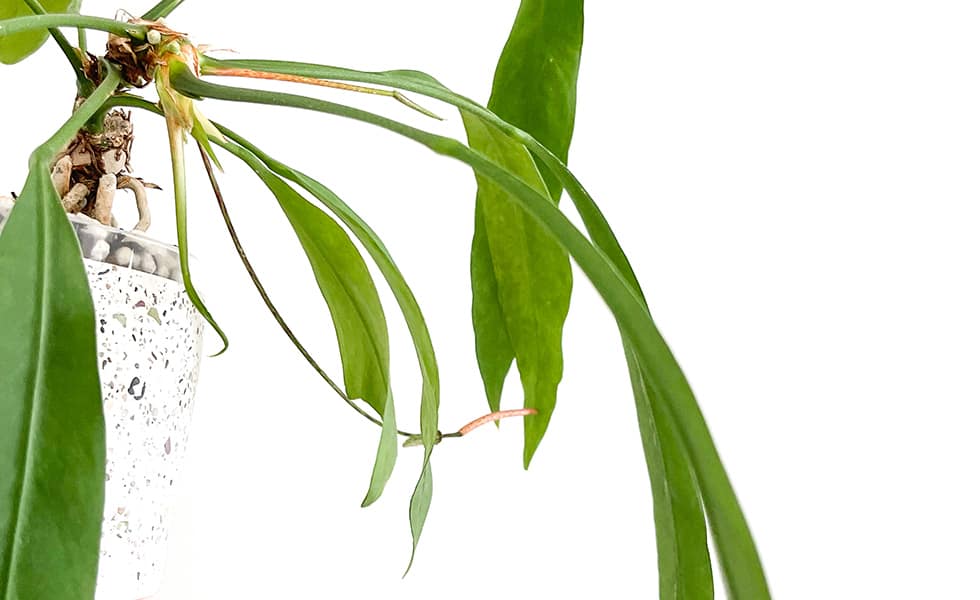
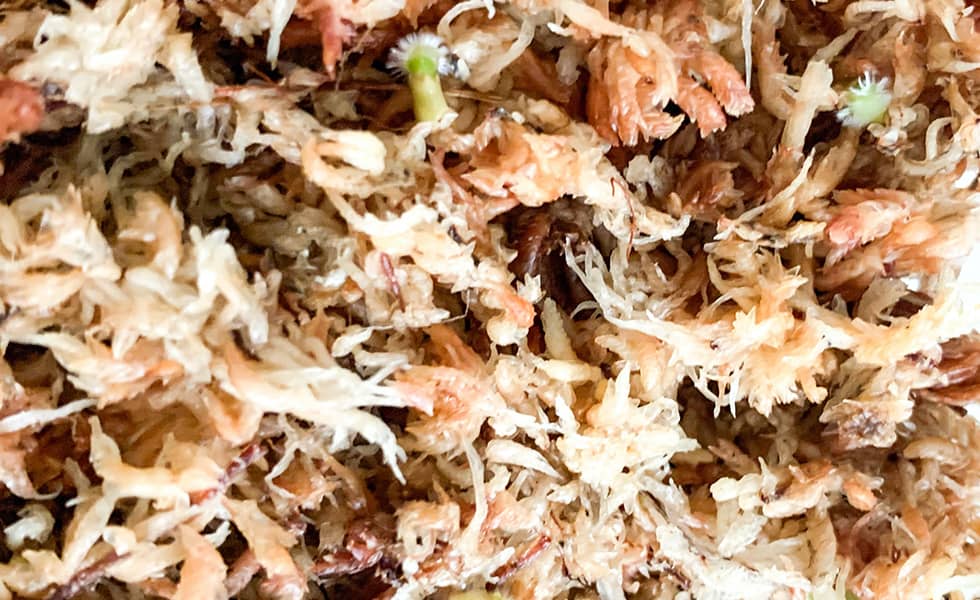
Place the seeds on damp sphagnum moss and cover to keep humidity high. In just a couple of days, you’ll see the seeds germinating.
The inflorescence on Anthurium vittarifolium emerges from a leaf petiole, so don’t trim the leaves prematurely!
This strap leaf anthurium produces inflorescences frequently and self-pollinates, but it needs to reach maturity for the seeds to set. I usually chop them off as soon as I see them because they drain much energy from the plant.
Often you’ll see the next leaf after the inflorescence is much smaller. The new leaves on juvenile plants start tiny and expand over time. If the plant is healthy and gets enough light, each new leaf is usually more prominent in size than the previous one.
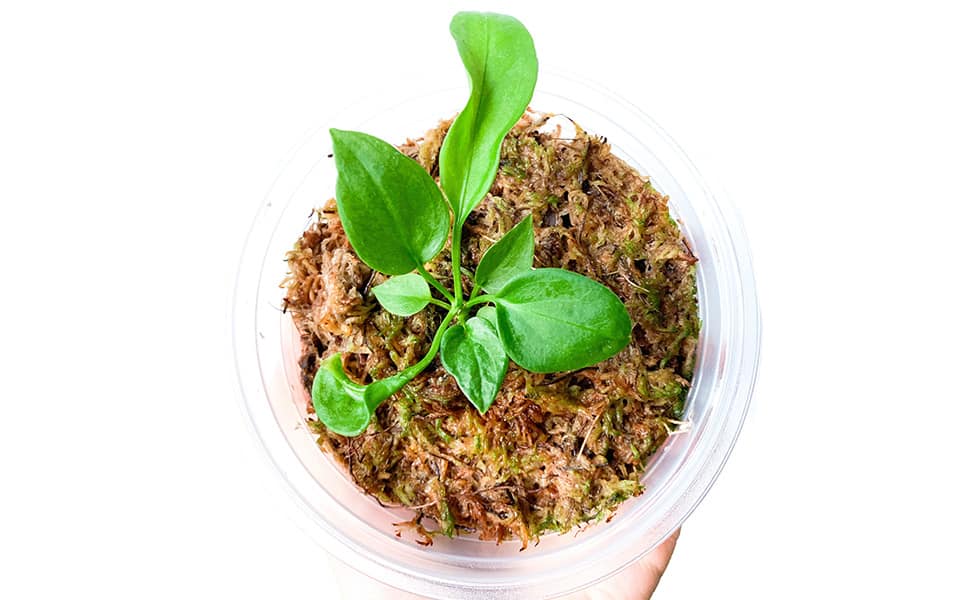
If you’re interested in how to propagate anthuriums from seeds, check out my Anthurium gracile blog, where you can see a step-by-step tutorial.
GROWING TIPS
New leaves are delicate, and as they expand in a low-humidity environment, the emerging leaf can be easily damaged. Frequent misting, having a humidifier next to the plant or putting a plastic bag over a new leaf to increase the ambient humidity will help.
Also, if pendent anthuriums don’t receive enough light, the leaves might become super narrow. I had it happen to me!
Experiment placing your strappy anthurium in various light conditions and see where it’s the happiest. Have a regular fertilizing schedule, and you’ll see fast growth.
Anthurium Vittarifolium vs Pallidiflorum
Curious to know how to tell the difference between Anthurium vittarifolium and another strap leaf anthurium, Anthurium pallidiflorum? One way to tell the two species apart is by looking at the sinus of the plant.
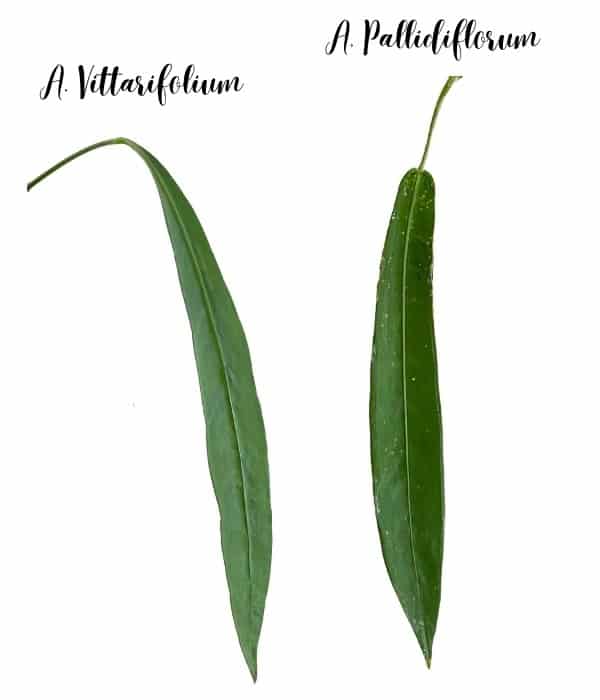
Anthurium vittarifolium has an acute sinus (where the petiole attaches to the leaf blade), forming a <90 angle, whereas Anthurium pallidiflorum has a rounded sinus.
Another way of differentiating is the leaf texture. Vittarifolium feels like leather, whereas pallidiflorum is velvety in texture.
ANTHURIUM VITTARIFOLIUM VARIEGATED
Anthurium vittarifolium has a variegated form. The variegated Anthurium vittarifolium doesn’t have sectoral variegation but blotchy strikes that almost look like a virus.
If you google Anthurium vittarifolium variegated photos, you’ll see that they look pretty sickly. I don’t own a variegated Anthurium vittarifolium, not only because of its hefty price tag but also because the variegation is highly unstable. It reverts to green form indiscriminately.
ANTHURIUM PALLIDIFLORUM
Anthurium pallidiflorum is another strap leaf anthurium native to Ecuador. The leaves on a juvenile form of Anthurium pallidiflorum are shimmery, velvety, and light green.
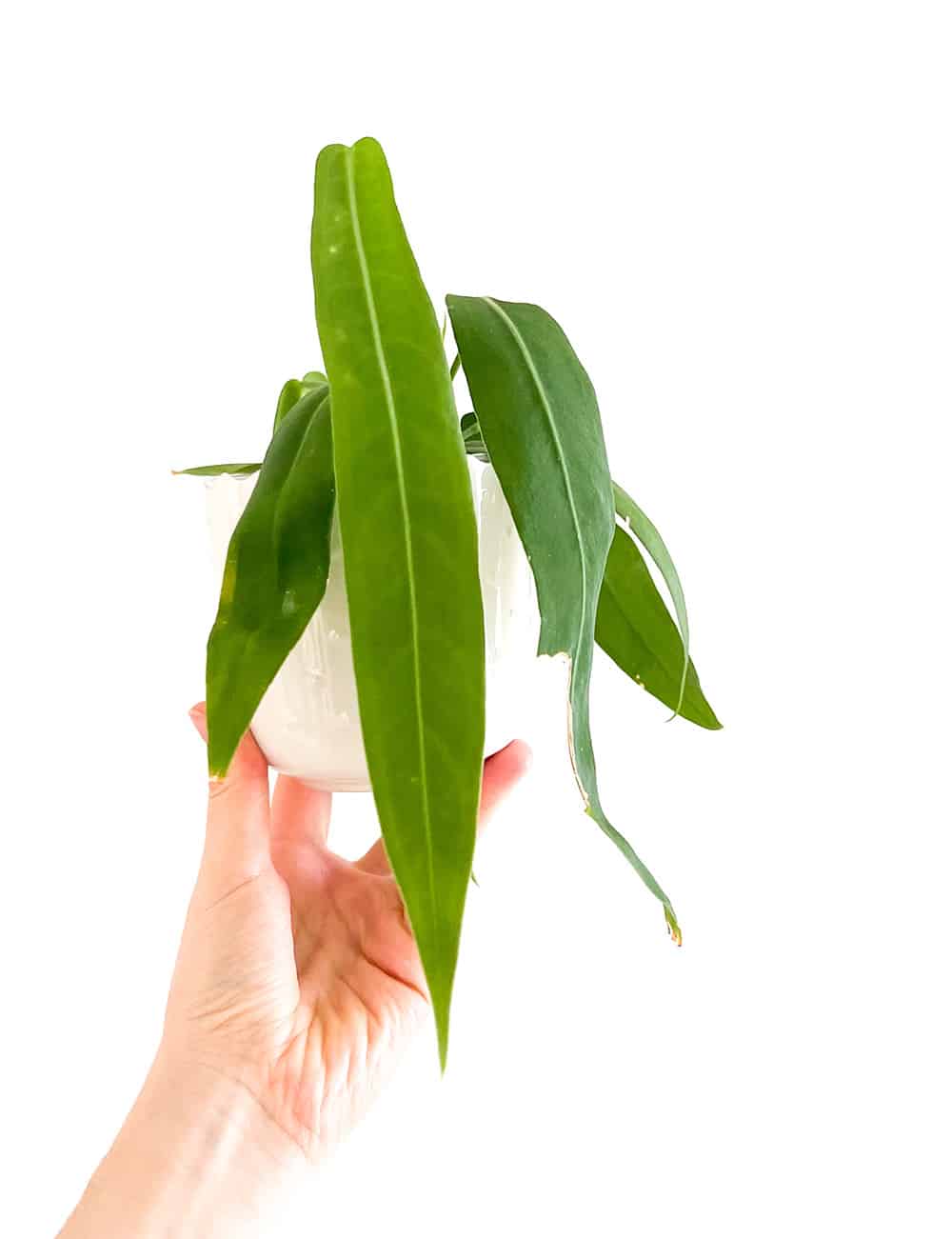
As it matures, the leaves will become longer, darker green, and the veining more pronounced. Unlike Anthurium pendens, whose leaves are primarily matte, the leaves on Anthurium pallidiflorum have a slight sheen.
And unlike Anthurium vittarifolium, which is more commonly found, Anthurium pallidiflorum is a rare aroid with pendent leaves.
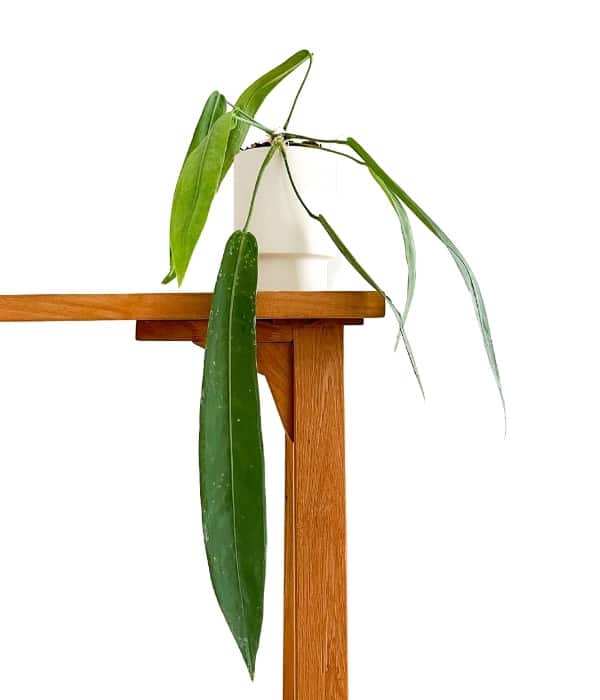
Anthurium Pallidiflorum Care
Anthurium pallidiflorum is an easy grower and pushes new leaves one after another. I found it hardy but a bit more thirsty than vittarifolium.
I care for Anthurium pallidiflorum the same way as Anthurium vittarifolium, except for more frequent watering.
ANTHURIUM FRIEDRICHSTHALII

Anthurium friedrichsthalii is another strap leaf anthurium worth collecting. This strappy one grows like a weed!
The leaves of Anthurium friedrichsthalii are more vibrant in color and more glossy on the surface than those of anthuriums vittariifolium or gladiifolium. But unlike Anthurium wendlingerii or vittarifolium, Anthurium friedrichsthalli is smaller and more compact.
In the beginning, I was letting every inflorescence grow in the hope of getting some seeds, but the subsequent leaves were getting smaller, so now I chop them whenever I spot them. ;]
Anthurium Friedrichsthalii Care
Like other pendent anthuriums, anthurium friedrichsthalii care consists of providing it with medium to bright indirect light, appropriate humidity, and light but frequent fertilizing. In my setup, this aroid lives under a grow light with about 55% humidity.
ANTHURIUM FRIEDRICHSTHALII VS VITTARIFOLIUM
How to differentiate Anthurium friedrichsthalii from vittarifolium? First, look at the leaf texture and shape. Anthurium friedrichsthalii has darker and glossy leaves, whereas vittarifolium has a lighter matte surface. Anthurium friedrichsthalii also has more narrow leaves and a very pronounced midrib.
ANTHURIUM FRIEDRICHSTHALII VS PALLIDIFLORUM
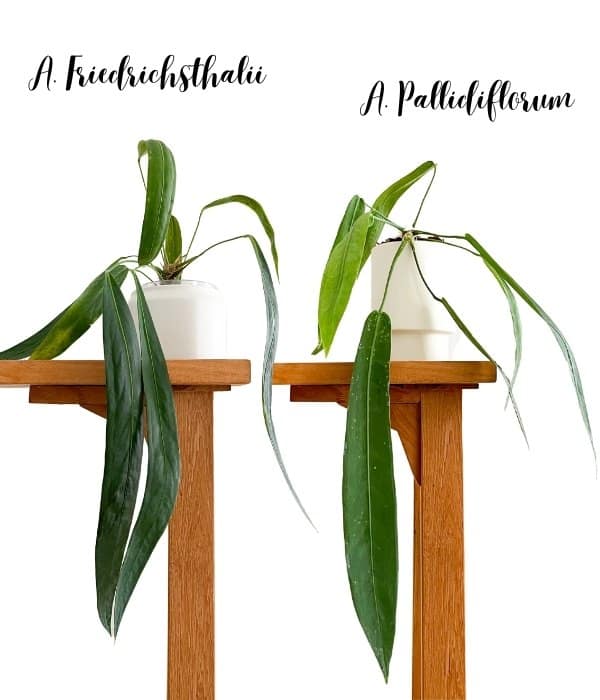
It is easy to tell the difference between Anthurium friedrichsthalii and pallidiflorum by looking at how the leaf blade attaches to the petiole. Anthurium friedrichsthalii has a very narrow and slender shape, whereas pallidiflorum is round.
ANTHURIUM PENDENS
Anthurium pendens is endemic to Panama. It is a rare aroid that is very difficult to find in cultivation. I don’t own one.
The leaves on Anthurium pendens are dark green and semi-glossy. They are elongated, with the broadest point at the middle of the leaves. Anthurium pendens midrib is visibly protruding and contrasting with the rest of the leaf.
As a pendent type of Anthurium, its apex grows downwards, and it doesn’t matter if you pot it upwards. It will always find its way down. It grows on other trees and attaches itself to the bark with its aerial roots and leaves just hanging towards the earth.
Like other types of epiphytic anthuriums, keeping the roots moist is critical to their overall health. Anthurium pendens have fuzzy-like fibers around their base.
The best way to differentiate between different species of strap leaf anthuriums is to compare their inflorescences. The inflorescence on Anthurium pendens is very short and unexciting, whereas Anthurium wendlingeri, for example, has a long inflorescence that looks like a corkscrew.
When pollinated, the infructescence is covered with bright red berries, and contrasting dark green leaves make a striking look.
ANTHURIUM GLADIIFOLIUM
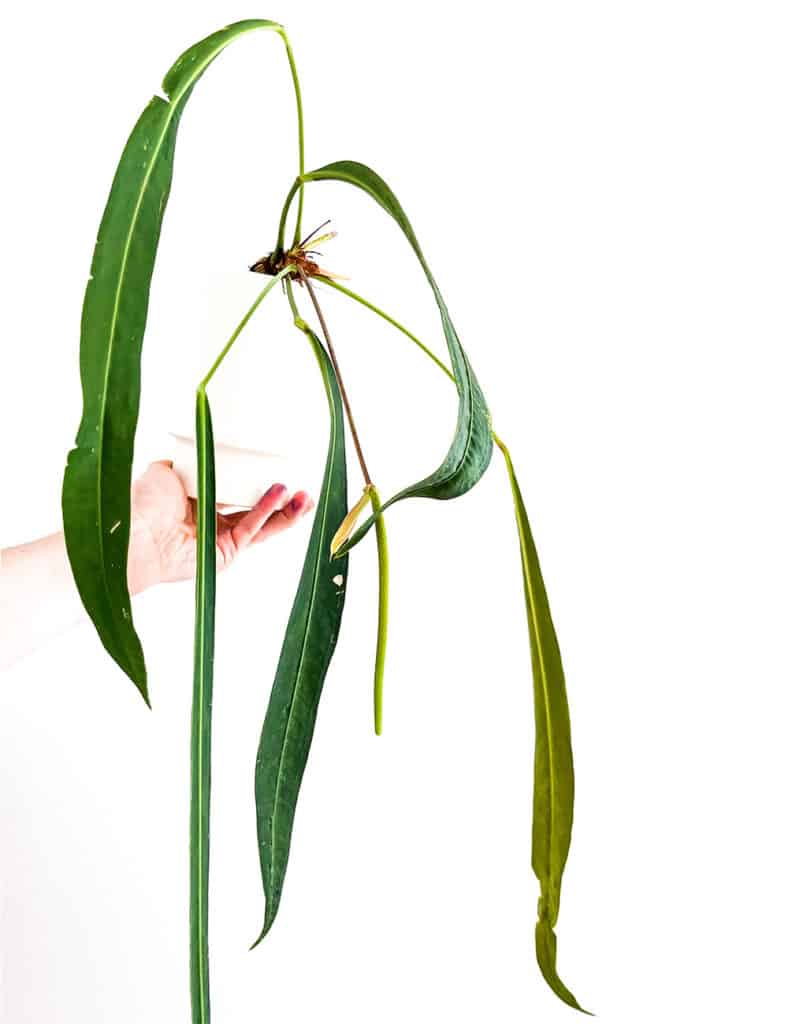
Initially bought as an Anthurium pendens type, this specimen turned out to be an Anthurium gladiifolium. The pendent-like leaves are widely-spreading. The color is matte green, slightly paler on the abaxial side.
The inflorescence can get quite long on a mature specimen. The care of anthurium gladiifolium is the same as for other strap leaf anthuriums.
They need humidity, frequent fertilizing, and bright indirect light. In my experience, Anthurium gladiifolium is a slower grower than Anthurium friedrichsthalii or vittariifolium.
ANTHURIUM WENDLINGERI
Anthurium wendlingeri is arguably the most recognizable strap leaf anthurium because of its characteristic corkscrew-like inflorescence. For a deeper discussion on Anthurium wendlingeri, check out the Exotica Esoterica post. And one other strap leaf anthurium deserves mention; a new hybrid called Anthurium Chainsaw.
ANTHURIUM CHAINSAW
Anthurium chainsaw is a hybrid of Anthurium wendlingeri and scherzerianum. Enid Offolter of NSE Tropicals successfully created it. It has spectacular inflorescence! You can read about it here.
STRAP LEAF ANTHURIUM SECTIONS
If you want to try your hand at pollination, you should check which section an anthurium belongs to. Usually, you can only cross species within the same section. But no one is saying you can’t try! Experiment and see what happens.
ANTHURIUM VITTARIFOLIUM
Section: Urospadix
ANTHURIUM PALLIDIFLORUM
Section: Leptanthurium
ANTHURIUM PENDENS
Section: Porphyrochitonium
ANTHURIUM GLADIIFOLIUM
Section: Urospadix
ANTHURIUM WENDLINGERI
Section: Porphyrochitonium
For more information on rare anthurium species, check out my other post, where I describe my favorite but often underrated species.
You may also be interested in these blogs:
Anthurium Bullatus, Pandurilaminum, or Bullatum? GET THE SCOOP
The Unrivaled Guide to Anthurium Effusilobum Care
A Really Quite Good Guide to Black Anthuriums

